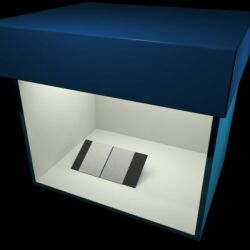 |
Computer Graphic Rendering of Material Surfaces |
 |
 |
Computer Graphic Rendering of Material Surfaces |
 |
NIST Data
Using the NEFDS measurement protocol, two surfaces painted with gray metallic paint were fit to the NEF-BM model. The paints were mixed so that one had mostly coarse metallic flakes while the other was dominated by fine metallic flakes. The paint with a greater number of fine flakes had a larger diffuse component due to more edge scattering. This is easily captured by the NEF-BM model and iBRDF as can be seen in Figure 18 below as well as the rendered images using this data. Figure 18 shows a good correspondence between the measured BRDF values and those obtained by evaluating the fit NEF-BM model. More detail is given in Nadal et al. [NADALxx]
Figure 18: In-plane near zero bistatic BRDF measurements of coarse and fine flake metallic sample. The data from the fine and coarse metallic samples obtained by following the NEFDS measurement protocol is available in Excel format:
In-plane BRDF measurements were performed on 30 G.U. (gloss units) and 70 G.U. gloss tiles and are available for download. These values were then compared to the BRDF values of two BRDF models with parameters selected by using the virtual light meter. Figure 19 is a plot of the BRDF values measured from the actual gloss tiles and the BRDF of a common analytical model versus reflected angle using light incident at 20 degrees.
Figure 19: BRDF values versus reflected angle for two gloss tiles with 20 degree gloss 30 G.U. and 70 G.U. The simulated gloss tiles using a common analytical BRDF models are also included. The model parameters were selected using the virtual gloss meter so as to achieve the same gloss values as the measured tiles.
|
Privacy Statement/Security Notice | Disclaimer | FOIA NIST is an agency of the U.S. Commerce Department's Technology Administration. |